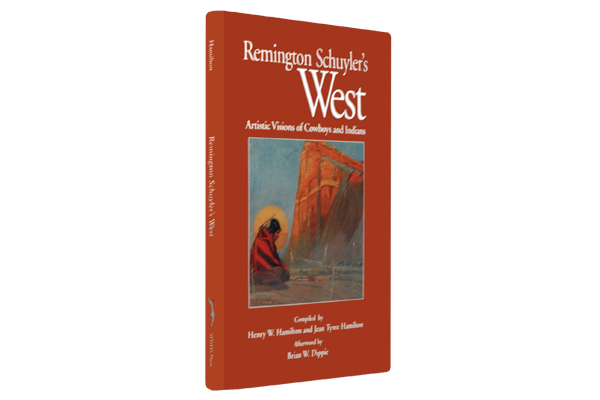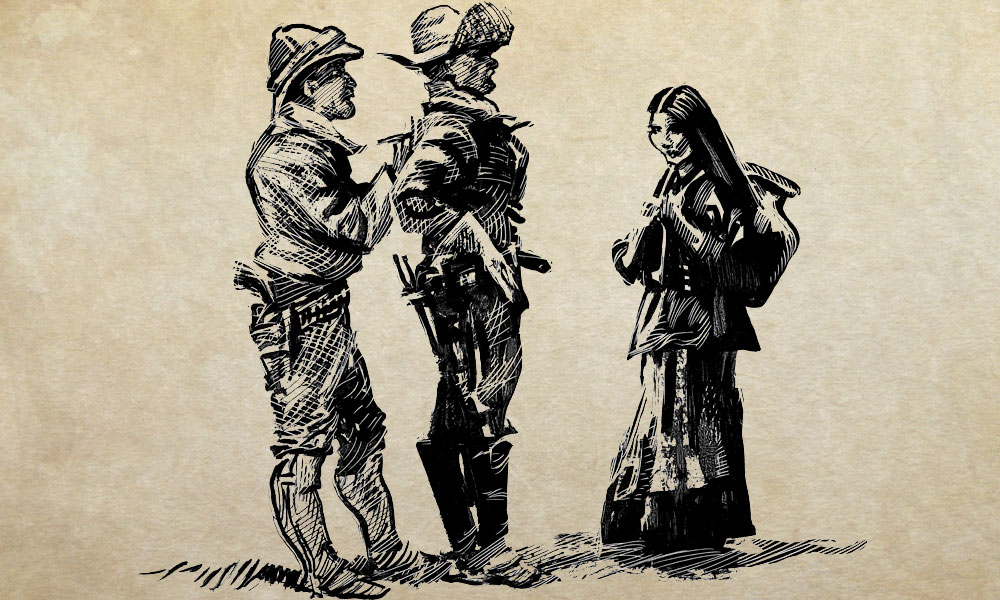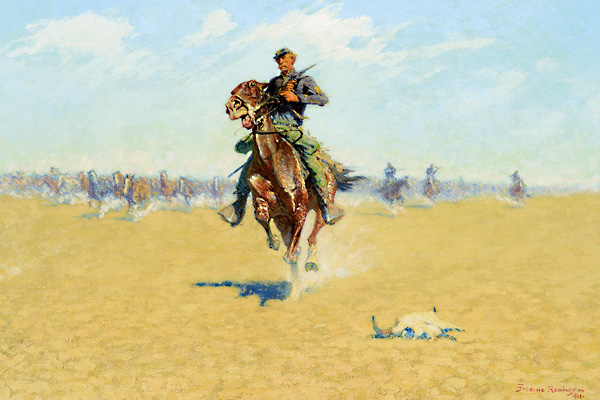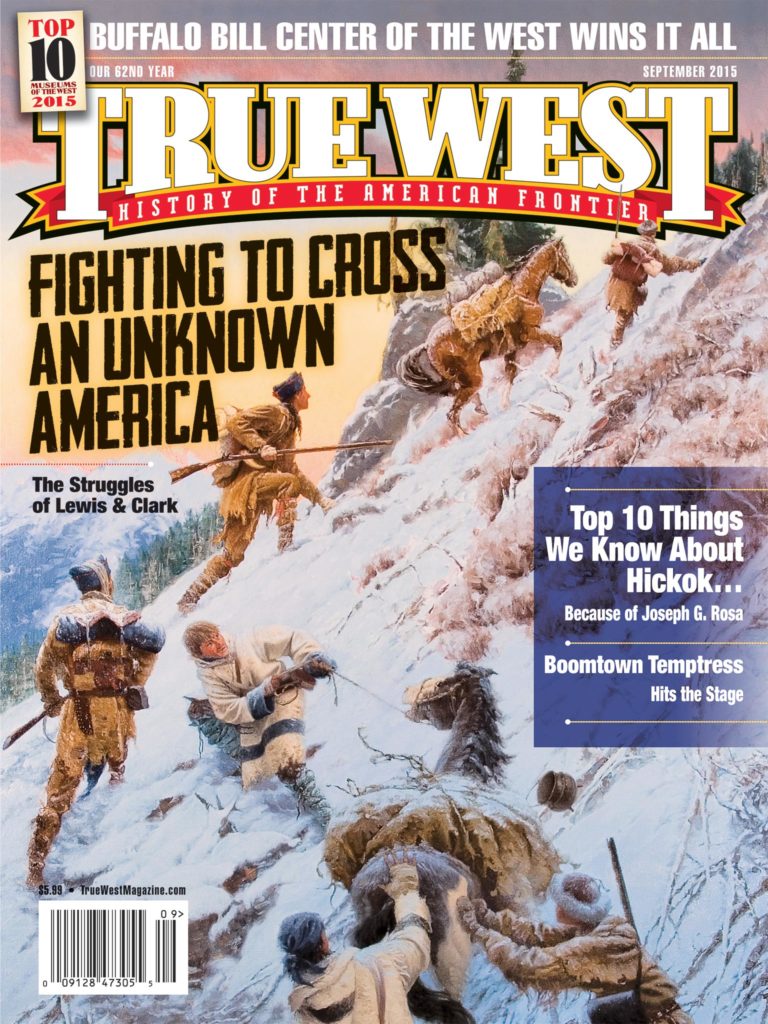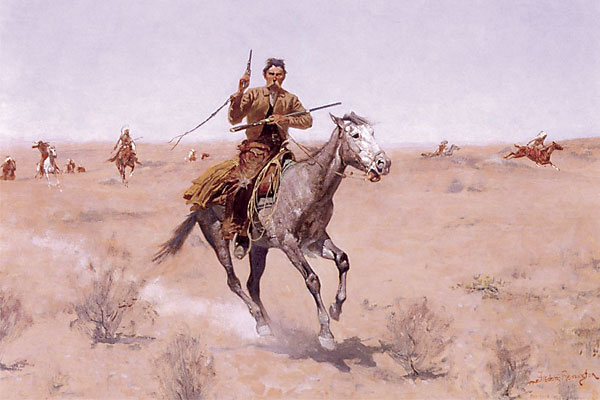
Frederic Remington was a shutterbug. It’s a simple fact. One of the greatest painters and sculptors of the American West was addicted to photography.
That jaunty figure, sporting a white pith helmet as protection against the blazing Arizona sun in his painting Marching in the Desert, was Remington himself, serving as artist/correspondent for an Eastern journal on a scout with the Tenth Cavalry in Apache country. It was June 1888, and the Geronimo outbreak he had covered for Harper’s Weekly a few years earlier was already a memory.
As an experienced military field artist, Remington had come to Arizona equipped with a pistol, carbine, sketch pad—and a Scovill Detective box camera. It’s hard to realize that he was as busy taking pictures as he was sketching them, but he was indeed. The Scovill had revolutionized photography by making it accessible to amateurs. Its 4×5-inch dry glass plates presented some challenges, but with a little training Remington had learned how to operate the apparatus and develop his pictures almost on the go. They were essential to the photographic realism of his illustrations, a realism that persuaded his contemporaries (and generations since) that he had faithfully recorded the unvarnished truth of life on the frontier.
Remington had people fooled. Humbuggery, for his generation, was trickery that raised deception to an art form. Its victims were willing dupes in the hands of a master showman like P.T. Barnum. What of an artist who
created scenes so realistic-looking, so photographically precise in their details, that they convinced viewers he had witnessed everything he showed? It didn’t matter if his stirring pictures of Apache ambushes and bloody stands and riderless horses racing away from fatal encounters were entirely imaginary—they looked more real than reality. Remington always recognized that the essence of the illustrator’s art was artifice.
“The men who do things are the real people,” he wrote. “The artists and novelists are the people who tell about them. . . . When you look at nature you know what you look at—you see what you see and what you do about it is art.” His art was to create a distinctive version of the West—”my West,” as he called it—and to persuade the world it was the real McCoy.
Capturing the West on Film
Born in 1861 in upstate New York, Remington relished the out of doors from boyhood. After coming into a small inheritance, he promptly quit the Yale School of Fine Arts and, in 1881, headed to Montana on the first of many trips to see a land where nature still ruled. He lived in the West for only one year, on a sheep ranch in Kansas. By 1886, his dramatic scenes of frontier life were appearing regularly in popular illustrated magazines.
Learning on the job, Remington mastered the tricks of the illustrator’s trade. The use of photographs was one. To make his West everybody’s West, he had to establish his frontier “types” as definitive. By 1892, with almost 1,500 drawings to his credit and most of them published, his cavalrymen, his Indians, his cowboys and scouts and Mountain Men and prospectors were so familiar that a journalist said, “It is a fact that admits of no question that Eastern people have formed their conceptions of what the Far-Western life is like, more from what they have seen in Mr. Remington’s pictures than from any other source.” Just that quickly he had won the field, with his Scovill Detective an essential weapon in his arsenal.
Remington first carried a camera with him in 1886 while in pursuit of Geronimo. He dreamed in color, but as an illustrator lived in a black-and-white world. The camera was an invaluable ally, supplementing sketches and color notes on the landscape (“The ground of the south west has more burnt sienna in it than I had thought”) by recording the precise details he needed in order to work up convincing illustrations. “After a good night rest” in Tucson, Arizona, he “went to the detachment of 10th Colored Cavalry—took a whole set of photographs.” He photographed soldiers, scouts, buildings and, at Fort Huachaca, a trooper posing for a painting he planned that would show Lt. Powhatan H. Clarke’s daring rescue under heavy Apache fire of a wounded man.
When Soldiering in the Southwest—The Rescue of Corporal Scott appeared on the cover of Harper’s Weekly that August, it proved a hit. Remington was heralded as the pictorial historian of the Indian-fighting army. He returned to Arizona in 1888 to “do the ‘Black Buffaloes’”—the Tenth Cavalry again. He formed a lasting friendship with Clarke during the two-week scout from Fort Grant to the Pinal Mountains and back, and photographed to his “heart’s content” among the cavalrymen at Fort Grant and the Indians at San Carlos and then Forts Sill and Reno in Indian Territory. “I took lots of instantaneous shots,” he wrote his wife. “Don’t know what they will be,” but he had high hopes. “I am getting material such as will make your eyes open.”
Besides the pictures he took on his Western excursions, Remington avidly acquired photographs from others. An important commission earlier in 1888 to illustrate a series of essays by Theodore Roosevelt on “Ranch Life” in Dakota allowed him to stake an artistic claim on cowboys as well as soldiers. He knew them from their boots up, contemporaries thought, though many of his illustrations relied on photographs provided by Roosevelt or acquired from the pioneer Miles City, Montana, photographer L.A. Huffman. Remington jotted Huffman’s address in a notebook, and he came close to tracing some of his pictures in the illustrations he signed without acknowledgment to Huffman. Years later, a friend indignantly informed Huffman that one of his photographs was “literally copied by Remington. . . . Did you know this?”
That was the problem with using a professional photographer’s pictures—others might recognize them too. So Remington began recruiting amateurs like Powhatan Clarke to shoot photographs for his exclusive use. “Glass plates are the only thing,” he told the lieutenant. Print film was unreliable. “With care all your glass exposures will be of use and photography is like love, one success is better than a thousand failures.” He even provided Clarke with a camera, along with suggestions about what to photograph and some technical advice: “Remember that you always over-expose in Arizona.”
Clarke was not his only source for pictures. Remington’s habits and tastes were well known within the army he was busily immortalizing during the final phase of the Indian wars. “Do I want the Indian photos?—does a duck swim?,” he asked a lieutenant of artillery he had met while covering the Sioux Ghost Dance War for Harper’s Weekly. One officer sent photographs of Crow Indians in uniform, another a batch of pictures taken at San Carlos Agency in the mid-1880s. They were all grist for the mill—something Remington could “work up” in his illustrations and paintings.
Remington knew he was over-reliant on photographs. In some of his illustrations, critics detected problems with perspective and a certain stiffness in the figures that were telltale signs of his addiction to photography. At the same time, since photographic realism had established his reputation with the public, he was not about to abandon the camera. In 1890, he even gave a Kodak a trial on a hard ride with Gen. Nelson A. Miles in Montana. “D— paper plates,” he grumbled, “—no good.” But he was soon a convert to the new technology, remaining as reliant as ever on photographs to create his work. When he described a group of black-and-white drawings in 1896 as “away from the Kodak,” he was acknowledging his dependence on his Kodak.
Creating Art in a Vanishing West
In the late 1890s, Remington relied on his pictures to recapture what used to be. The passage of time had eliminated the human interest he once found on his earlier travels to the West. His frontier types were no more. Only 12 years after scouting with the Buffalo Soldiers in Arizona, he wrote his wife from Santa Fe, “Shall never come west again—It is all brick buildings—derby hats and blue overhauls [sic]—it spoils my early illusions—and they are my capital.”
Of course, Remington did go West again, to reacquaint himself with light and color and the land itself. Photographs of Western settings and structures still served the same purpose as landscape studies in oil. “I make them,” he told an artist friend, “to insert figures afterwards.” Figures charging. Figures fleeing. Figures dying. Mayhem galore—all dreamed up in one man’s imagination.
By the end of the 19th century, Remington was restless in his role as the West’s peerless pictorial historian. He craved recognition as a creative artist and turned his back on photographic realism. Two years before his death, in 1909, he told a reporter, “I do not employ photography at all now, though I once found it a great help. In a sense I’ve gotten all the good out of it I can get and now I want to work entirely away from it.”
Yet Remington continued to incorporate photographs in his later, impressionistic oil paintings. But his point is well taken; his priorities had shifted. The artist no longer wanted to be regarded as a faithful recorder of the varnished truth. He was now painting the “Grand Frontier” from pure inspiration.
Back in 1888, when Remington drew himself sketching an Apache woman while using Powhatan Clarke as a prop and shield, photographic realism was his main claim to fame. Perhaps he should have shown himself, not with a sketch book, but with a Scovill Detective box camera in the crook of his arm.


